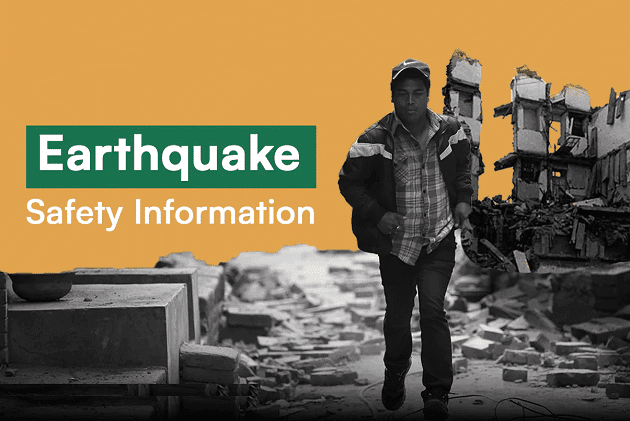Earthquake Safety Information: Tips & Guidelines 2025

Earthquakes strike suddenly and without warning, shaking the very ground beneath our feet and often leaving destruction in their wake. As we progress through 2025, understanding earthquake safety information is more critical than ever. baddiehub With growing urban populations, aging infrastructure, and climate-related shifts affecting seismic activity patterns, having solid knowledge and preparation strategies can save lives.
This article delves deep into the essential tips and guidelines for earthquake safety in 2025, providing you with actionable information before, during, and after an earthquake. Whether you live in a known seismic zone or an area with low risk, preparedness benefits everyone.
Understanding Earthquake Risks and Preparedness
Earthquakes occur when stresses within the Earth’s crust cause sudden movements along fault lines. These tremors generate seismic waves, which lead to shaking on the surface. Depending on the magnitude, location, and depth of the quake, damage can range from minor to catastrophic.
To frame the discussion about safety, let’s first look at the key parameters that affect earthquake risk:
| Parameter | Description |
| Magnitude | Energy released during an earthquake (measured on the Richter or Moment scale) |
| Epicenter | The surface location directly above where the quake originates |
| Depth | How deep below the surface the quake occurred |
| Distance from Epicenter | Proximity of the location to the epicenter influences shaking intensity |
| Local Geology | Soil and rock type can amplify or dampen seismic waves |
| Building Construction | Structures built to seismic codes withstand quakes better |
These variables help determine both the potential for damage and the necessary safety measures for any given area.
Earthquake preparedness starts with awareness — understanding these factors and how they relate to your location, home, or workplace. The more informed you are, the better equipped you’ll be to act decisively when seconds count.
Key Earthquake Safety Tips Before the Quake
Preparation before an earthquake is your best defense against injury and loss. Consider the following essential safety tips, carefully planned for the realities of 2025 living:
- Develop a Family Emergency Plan
Create a detailed plan that identifies safe meeting places, emergency contacts, and evacuation routes. Practice drills regularly to ensure everyone understands the steps. - Secure Heavy Objects
Fasten shelves, cabinets, televisions, and water heaters to walls with appropriate hardware. Heavy items falling pose serious risks. - Assemble an Emergency Kit
Stockpile supplies to last at least 72 hours. Include water, non-perishable food, flashlight, batteries, first aid, medications, important documents, and cash. - Identify Safe Spots
Determine safe locations indoors such as under sturdy tables or against interior walls away from windows or heavy fixtures. - Retrofit Your Home
Where feasible, upgrade your house structure with seismic reinforcements, especially if built before modern codes. - Stay Informed
Subscribe to local alert systems and apps that provide real-time updates and earthquake warnings.
| Emergency Kit Essentials | Recommended Quantity |
| Water | 1 gallon per person per day (minimum 3 days) |
| Food | Non-perishable items for at least 3 days |
| First Aid Kit | Comprehensive kit including bandages, antiseptics |
| Flashlight and Batteries | Multiple, with extra batteries |
| Personal Medications | Minimum 1-week supply |
| Important Documents | Copies of ID, insurance, medical records |
| Cash | Small bills and coins for emergency purchases |
These preparatory steps may seem simple but can make the difference between safety and tragedy.
What to Do During an Earthquake
When the ground starts shaking, instinct takes over — but the right action can save lives.
- Drop, Cover, and Hold On: Immediately drop to your hands and knees to prevent falling. Take cover under a sturdy table or desk. Hold on firmly until the shaking stops. If no cover is available, crouch against an interior wall and protect your head and neck with your arms.
- Stay Indoors: Running outside during shaking increases injury risk from falling debris. Stay inside and avoid windows, glass doors, and exterior walls.
- If Outdoors: Move to an open area away from buildings, power lines, trees, and streetlights. Drop to the ground and protect your head.
- If Driving: Pull over safely to the roadside away from overpasses, bridges, or power lines. Stay in the vehicle until shaking stops.
- Avoid Elevators: They may malfunction during quakes.
The unpredictability of earthquakes demands quick thinking but calm execution.
Post-Earthquake Safety Guidelines
Once the shaking subsides, dangers remain. Follow these critical steps after the quake:
- Check for Injuries and Provide Aid
Attend to yourself first, then family members and neighbors. Avoid moving seriously injured individuals unless they are in immediate danger. - Inspect Your Surroundings
Look for gas leaks, damaged electrical wiring, structural cracks, and water line breaks. If you smell gas, turn off the main valve, evacuate immediately, and report to authorities. - Prepare for Aftershocks
Aftershocks can be nearly as powerful and damaging. Stay alert and be ready to Drop, Cover, and Hold On again. - Use Text or Social Media for Communication
Phone networks may be overloaded; texts and social media are often more reliable. - Follow Official Instructions
Listen to emergency broadcasts for updates on shelters, road closures, and relief efforts.
| Post-Earthquake Actions | Recommended Steps |
| Injury Assessment | Provide first aid; call emergency services if needed |
| Hazard Identification | Check for gas leaks, fires, structural damage |
| Communication | Use text messages or social media to conserve phone lines |
| Aftershock Preparedness | Stay in safe spots; avoid damaged structures |
| Official Updates | Monitor local authorities for instructions |
Adhering to these guidelines minimizes the risk of secondary harm and aids recovery.
Building Community Resilience
No individual is an island, especially during disasters. baddiehub Communities prepared collectively fare better in the face of earthquakes.
- Conduct Regular Drills: Schools, workplaces, and neighborhoods should hold earthquake drills.
- Strengthen Infrastructure: Retrofit public buildings and utilities to meet seismic standards.
- Train Volunteers: Establish emergency response teams for search, rescue, and medical aid.
- Educate Public: Use media campaigns to spread earthquake safety knowledge.
- Develop Communication Networks: Maintain robust, redundant systems to stay connected during emergencies.
Wrapping Up
Earthquakes don’t send a warning before they strike — but preparation gives us power. Whether you live in a high-risk zone or an area that rarely feels tremors, the information you’ve just read isn’t just helpful — it could be life-saving.
In 2025, staying informed, practicing safety drills, securing your space, and building community awareness aren’t just recommended — they’re essential. Remember, when the ground starts to move, it’s your preparation that will hold everything steady.
So take action today. Build your emergency kit. Secure your furniture. Talk to your family. Stay alert. And most importantly, don’t wait for the next big one to remind you that earthquake safety information is more than just knowledge — it’s survival.
Frequently Asked Questions (FAQs)
Q1: What should I do if I’m outside during an earthquake?
A: Move to an open area away from buildings, power lines, trees, and streetlights. Drop to the ground and protect your head and neck until shaking stops.
Q2: How can I prepare my home for earthquakes?
A: Secure heavy furniture and appliances, retrofit foundations if possible, and identify safe spots indoors away from windows and heavy objects.
Q3: Is it safe to run outside during shaking?
A: No. Running increases the risk of injury from falling debris. It’s safer to Drop, Cover, and Hold On inside.
Q4: What items are essential in an emergency earthquake kit?
A: Water, non-perishable food, first aid supplies, flashlight with batteries, medications, important documents, and cash.
Q5: How long do aftershocks last?
A: Aftershocks can occur for days or weeks after the main quake, typically decreasing in frequency and intensity over time.
Q6: Can earthquakes be predicted?
A: No reliable method exists to predict the exact time and location of earthquakes. Early warning systems can provide seconds to minutes of notice in some regions.
Q7: What should I do if I smell gas after an earthquake?
A: Immediately shut off the gas valve if safe to do so, evacuate the building, and report the leak to authorities.
Earthquakes may be sudden and uncontrollable, but with the right knowledge and preparation, we can greatly reduce their impact on our lives. Make 2025 the year you commit to learning and practicing earthquake safety information — because safety starts with awareness and action.





